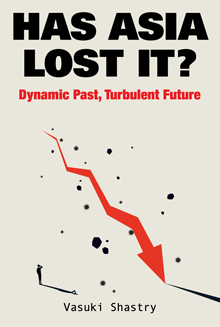Has Asia Lost It? Dynamic Past, Turbulent Future

Vasuki Shastry
World Scientific Publishing
Singapore, 2021, 332 pp., $68
Asia is the continent of the future and always will be: this is Vasuki Shastry’s grim prediction of Asia’s prospects, a contrast to conventional wisdom, which projects—linearly—the continent’s outstanding economic performance of recent decades into the future and sees it regaining by 2050 the parity in incomes it enjoyed with Europe around the 1500s. In Has Asia Lost It? Dynamic Past, Turbulent Future, Shastry attributes a large part of Asia’s success to the regional security offered by the United States and the spread of globalization, which provided an export-led economic model that helped many countries lift average incomes and millions out of poverty. But in coming years he sees the tussle for supremacy between the United States and China eroding regional security and threats to globalization arising from nationalistic sentiments all over the world.
To these headwinds, Shastry adds a long list of factors that will stunt Asia’s prospects. The continent’s political leaders, he writes, are mostly old men bereft of new ideas on how to propel growth and job creation while addressing the severe environmental damage in the region. Many politicians are in what Shastry bluntly calls a “malign partnership” with the billionaire class in their countries, engaged in various rent-seeking activities—"a charming economics expression,” he writes, that obscures the fact that when the “private sector and government are on the same side, it is not always evident if the general public benefits.” This enormously wealthy group lacks compassion for the plight of the lower-income millions who, while they have undoubtedly benefited from Asia’s growth, still live in difficult, often deplorable, conditions. These include rural migrants to Asia’s overburdened megacities; foreign household workers (housekeepers, for example) who labor outside their home countries without social protections; and the teenage girls who, in the best of circumstances, lack the opportunities afforded to boys and, in the worst of circumstances, are sold into prostitution and slavery, sometimes by their own parents.
Shastry’s polemic cites extensive research from experts and exploits the author’s knowledge of Asia—over his career he has been a business journalist in many Asian cities and a senior advisor at the IMF, the central bank of Singapore, and a private sector bank—and his connections to the region’s elite, with whom he rubs shoulders at Davos and other summits. What shows through in the book though is Shastry’s compassion for the continent’s ordinary people, like the rickshaw driver Pramod, who berates him for not acknowledging that the lives of millions like himself, while no longer short, remain nasty and brutish. Pramod stays with “three other friends in a tiny shack in one of Mumbai’s teeming slums without modern plumbing or running water,” while billionaire Mukesh Ambani has a residence with “27 floors, 600 staff, a ballroom and three swimming pools” for his clan of five.
Despite the compelling case he makes that Asia is losing its way, Shastry appears unwilling to abandon hope, and one senses that he longs for his prediction for the continent’s future to be proved wrong.
Opinions expressed in articles and other materials are those of the authors; they do not necessarily reflect IMF policy.









